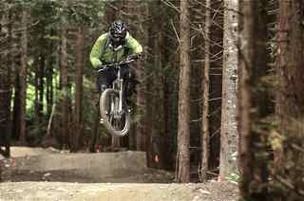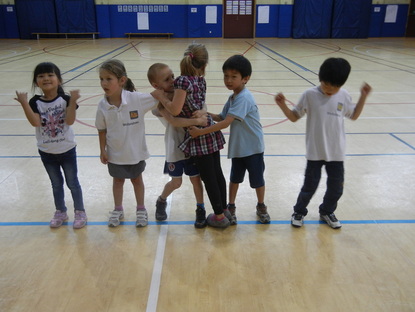|
Getting lots of different perspectives on teaching is important to me when I ask people to be guest bloggers on pyppewithandy. I am particularly interested the journeys of teachers new to the PYP. I vividly remember what it was like to be in my first year of teaching in the PYP. At the time, there were very few resources available to help me with my understanding of the role of the PYP in PE. I felt lost at times and did not have many people to bounce ideas off or ask for advice which made my job difficult to say the least. Although I was trained to teach PE, I still felt as though I was at a disadvantage because I knew so little about the PYP at the time (2001).
I have asked Shannon Carroll, a first year PYP teacher from Melbourne, Australia, to be a guest blogger and describe the process that he has gone through in trying to learn how to apply the PYP model to PE. I believe that his perspective is a very important one to consider as he has fully embraced being new to the PYP and has actively taken initiative to learn as much as he can about it. Shannon makes a very important point in that we are never alone on the journey of trying to become better teachers, especially nowadays. There are always more experienced colleagues that can guide and lead us on this journey. With social platforms such as Twitter and Facebook, as well as the number of excellent educational blogs out there, we are always in a position to learn from others is that is our intention. I thank Shannon for contributing to the pyppewithandy blog. A bit about Shannon: Shannon studied at Deakin University, in Melbourne and graduated in 2010. He is in his second year of teaching and his first year in the PYP. Shannon is currently employed at Mt Scopus Memorial College in Melbourne. He enjoys Australian Rules Football, surfing, tennis and golf. Discovering the PYP – A First Year Physical Education Perspective Commencing employment at a new school can be a daunting and overwhelming experience at the best of times. There is always an array of new information to comprehend and commit to memory, including the school’s curriculum and educational programs. The following is a brief passage on my journey, discovering the PYP, as a Physical Education teacher. The IB was first introduced to me briefly at university. The understanding I gained is that the IB is an international educational program, common around the world. I graduated from university and worked for a year before commencing employment at a PYP school, Mount Scopus Memorial College in Melbourne, Australia. I still had little knowledge of the PYP. The PYP to me first seemed very large and confusing. There seemed to be a lot of jargon which I had never heard before. Staff at the colleagues ensured me, that it will all soon become a second language to me. These opinions turned out to be correct. At first, I was unsure of how to link the units of inquiry, trans-disciplinary themes, concepts etc. to physical education lessons. The best approach I could think to take was to look at the PYP with open eyes, utilize the support of the staff around me and collaborate with other PE PYP specialists, not only in Melbourne, but around the world. As time passed, I began to find the PYP very inviting. Within the first few weeks working at the College, I noticed how the PYP added another layer of depth to the teaching and learning at the school. This I had never encountered before. I saw how students questioned, inquired and explored different topics. This inspired me to delve further into the PYP in my physical education lessons. This is when I started enlisting the help of the staff around me, and collaborating with other PYP PE specialist staff locally and around the world. We shared ideas, stand-alone units, games, activities, lessons etc. I was able to take this valuable information and modify it to my own teaching, and my own work program. I modified and used some ideas which worked well for me and I developed some of my own ideas, based on the knowledge of others. This is when I discovered that there are many aspects of the PYP curriculum which I already incorporate in my teaching and learning. All I was doing now, was putting a name to it, and documenting it in the PYP format. This eliminated the time constraints of adding additional content to my lessons, and changed my focus to incorporating the PYP into my current work program content. The IB creates international citizens, and sport crosses the boarders of almost every culture. Examples of everyday components of PE lessons, linking to the PYP include; sharing, risk-taking, balance, open-mindedness, reflection, structure, organisation, goal-setting, respect, integrity, cooperation, curiosity, commitment, confidence, appreciation, causation and responsibility. With these present in PE lessons, it is easy to create PYP links to classroom units and create stand-alone PYP units of work. Once I had this realisation, the valuable PYP links I was able to make in physical education classes strengthened. This approach to incorporating the PYP into PE is one which I will continue to follow and wii strive to enhance in the future.
4 Comments
 I am happy to have Ken share good teaching practice on this blog. He and I have recently been discussing ideas that he could blog about and he told me about an excellent plan that he and the maths teachers at Western Academy Beijing have been collaboratively working on this school year. It is definitely worth reading this blog as authentic and genuine learning is taking place. I look forward to seeing how this project plays out next year. Ken Forde went to the University of Victoria in British Columbia, Canada. He studied physical education and geography graduating in 2004. Soon after graduating he accepting a teaching position at a public school in the UK spending 3 years there. Opportunity led him to teach in United Arab Emirates where he was introduced to the IB and PYP frameworks. He taught in UAE for 4 years before moving on to Western Academy Beijing this year. It is his first year teaching in China and his first year of the MYP. Ken is passionate about football, but injuries have cut short competitive play, but this has allowed him to put more focus on his coaching which has been a valuable experience for him. HPE and Math Integration The idea of curriculum integration through PE was introduced as a theory to me while in university, however, the practical application of it was very limited in the BC provincial and UK national curriculum frameworks in which I started my career. It was not until moving into an IBPYP school in the 4th year of my career that the true possibilities for cross-curricular integration became clear. But even at this time many of the links were forced efforts to tick boxes, rather than create truly authentic learning experiences for the students. Upon reflection these early efforts were well intentioned but lacked a clear understanding of how integration could work outside of classroom curriculum subjects. Now, after 4 years of PYP, and finishing my first year of MYP, the possibilities for authentic integration seem to be popping up on a regular basis. This post will share a specific example of integration between Math and HPE that myself and another teacher are planning for next year. One of the middle school Math teachers was looking for data to use in a statistics unit. She came to me asking if we had any. You can only imagine both our excitement at not only having this data but the opportunity for the kids to apply math curriculum learning to their own performances; truly authentic integration. This year, as many HPE departments do, we ran a series of fitness tests for all students in the middle school. These included the 20M beep test, Illinois Agility Test, Push Ups (30s), Sit-ups (60s), Vertical Jump and Sit & Reach. These tests were performed four times this school year, providing us with a mountain of data and limited ways of using and displaying it. The plan for next year is to use the data from 2011-2012 during math classes. The students will use these data sets to calculate some statistical results such as mean, median, mode and standard deviation (SD) of various groups; gender, grade, test type etc. Once we have these basic statistics established, the students will incorporate this knowledge into their personal goal setting for the fitness unit. Hopefully this will help them create much more realistic and achievable goals based around the idea of means and percentile categories. Learning about and calculating standard deviation with anonymous data sets can be a good introduction to the concept, but learning SD with their own data becomes a much more relevant and authentic task as the results and analysis directly apply to them. For example, understanding the mean beep test score for all grade 7 boys is 8.6 provides a very narrow scope for goal setting, they are either above or below, which in a students eyes means they are either better or worse. Applying statistical tools such as SD in Math class will allow students to see where they fit within a bigger picture and apply it to within their goal setting. The final benefit of this integration will be the ability to create school based fitness norms. I have never liked using external fitness standards as the tests all vary slightly and no single set of tests and standards is a perfect match to any school in terms of facilities, equipment or time constraints. This results in many schools creating a hybrid series of tests. In my current school, fitness testing for students is not linked to any performance aspect of their assessments. What I feel is important for students to gain out of fitness testing is a chance to see personal improvement, and reflect upon the processes that allowed this to occur. Allowing them to see where they compare within the school population may help reinforce a positive mindset towards physical activity, but more importantly may provide a struggling student with the confidence that personal improvement is achievable. Using school developed norms will provide a much more accurate comparison for students than us applying an arbitrarily selected series of national or international fitness norms.  The only equipment needed for this cooperative challenge is lines on the gym floor. If you don't have that, you can be super creative and think of something else that can be used. The main idea is that the kids must keep their feet on the line during this activity.This is a very entertaining challenge to watch, the kids love it, and it really does require teamwork and cooperation. Please view the video below for a full explanation and to see video of the kids in action. |
AuthorKAUST Faculty, Pedagogical Coach. Presenter & Workshop Leader.IB Educator. #RunYourLife podcast host. Archives
September 2022
|
- Welcome
- All Things Teaching and Learning
- The Aligned Leader Blog
- Consulting and Coaching Opportunities
- My TED X Talk
- My Leadership Blog
- Run Your Life Podcast Series
- How PYP PE with Andy Has Helped Others
- Good Teaching is L.I.F.E
- The Sportfolio
- Example Assessment Tasks
- PYP Attitude Posters (printable)
- Publications
 RSS Feed
RSS Feed
